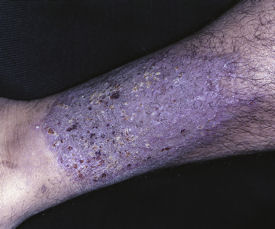MKSAP quiz: Treating an itchy rash on hands and arm
A 20-year-old male college student is having trouble sleeping because of an itchy rash on his hands and inner aspect of his arm. His pruritus has been recurring for several years, becoming more severe in the winter despite his use of a daily moisturizer. His history is remarkable for seasonal allergies, and the only medication he uses is a nasal corticosteroid in the fall.
The physical examination, including vital signs, is normal, except for the skin examination, shown in the figure.

Which of the following is the most appropriate treatment for this patient's condition?
A. Topical corticosteroids
B. Topical tacrolimus
C. Oral antibiotics
D. Topical antifungals
E. Oral corticosteroids
Answer and critique
The correct answer is A. Topical corticosteroids.
This patient has atopic dermatitis, most commonly associated with a rash in the creases of the skin and on the hands. Topical corticosteroids are best suited to treat moderate to severe symptoms of this condition when the patient is already using topical moisturizers (emollients), the typical first-line treatment. Severity is determined by involvement of more than one location, presence of sleep disturbance, and poor response to topical moisturizers. For the face, neck and intertriginous areas, only mild topical corticosteroids should be used. For the rest of the body, the lowest effective potency should be used intermittently, such as twice per week, to avoid thinning of the skin from regular topical corticosteroid use.
Topical tacrolimus may as effective as topical corticosteroids, but topical tacrolimus is indicated only for moderate to severe dermatitis that is unresponsive to topical corticosteroids, or for patients who cannot tolerate topical corticosteroids. Topical tacrolimus might also help where only the lowest-potency topical corticosteroids can be used, such as on the face, neck, and intertriginous areas. In March 2005, the Food and Drug Administration released an alert establishing a potential connection between the use of topical tacrolimus and lymphomas and skin cancers, based on case reports and studies in animals. For this reason, tacrolimus should be used only for short-term and intermittent treatment.
Oral antibiotics and topical antifungals cannot be used to effectively treat atopic dermatitis.
Oral corticosteroids are recommended only for a severe flare-up of dermatitis that is unresponsive to topical treatments. The support of a specialist, if available, is also recommended. No randomized trials support the use of oral corticosteroids; the optimal dose and length of treatment are unknown.
The criteria for the diagnosis of atopic dermatitis includes evidence of itchy skin plus three or more of the following: 1) involvement of the skin creases, including areas around the neck or eyes, elbows, knees, and ankles; 2) history of asthma or hay fever; 3) history of dry skin during the past year; 4) onset in a child younger than 2 years of age; and 5) visible dermatitis of skin flexures.
Key Point
- Topical corticosteroids are the best treatment for atopic dermatitis in patients who are already using topical moisturizers.





